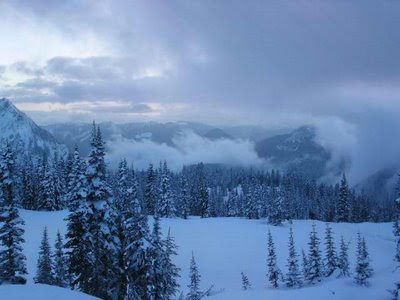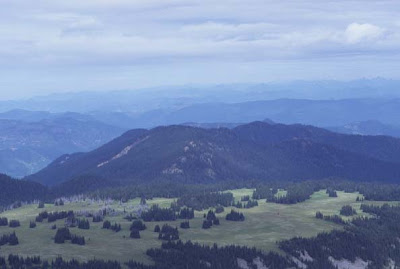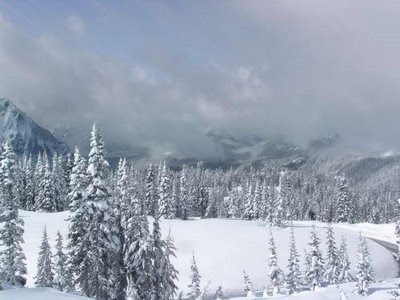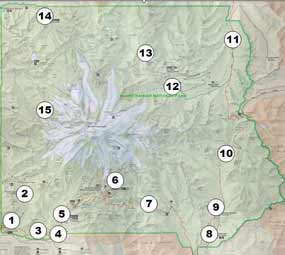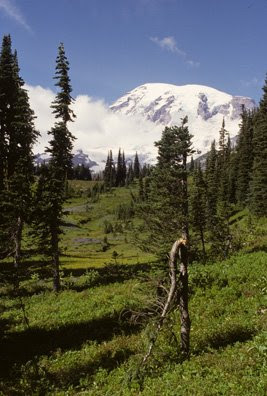
If you have made the decision to visit Mt. Rainier National Park (NP), the next question is the obvious one, where? This decision really depends on where you are starting from and how much time you want to spend in the car travelling to and in Mt. Rainier NP. I have a
visitors guide to the four different entrances. It would help to get out a road map to see the places, distances, and roads on your way.
To start with a planned trip, there are the four entrances, and unless you want to do to three-quarters circumnavigate trip, which is a very long day in the car, you should decide on one entrance and focus your time on the views, hikes, and photo opportunities in that area. If you come from Seattle, that means focusing on the eastern half, the White River Entrance, from Tacoma the western half, the Carbon River and Nisqually Entrances, and from Portland, the Ohanapecosh Entrance.
If you have more time than a day or so, then you can find accomodations near the NP where you can explore other entrances or take more time in a particular area. There are many miles of trails you can hike into the NP away from the crowds and get some excellent photo ops. And some areas have great easy access photo ops, such as,
waterfalls. And don't forget the many turnouts and viewpoints in the NP and on the roads around the NP.
Ok, that said, what is there? Some Websites with overview and trail information and maps are:
NPS Trail Guide,
Visit Rainier,
Wiki Travel and
National Park Service.
Below is a brief description with information and resources of the places available within a short drive from the four entrances and in and around the Paradise visitors area. At the present time (September 2007) the road from Chinook Pass to the Stevens Canyon turnoff to Paradise and to the Ohanapecosh entrance is closed due to a landslide from the Novemeber 2006 storms.
The most popular entrance is the
White River entrance, the closest to Seattle. This is also the road to the Crystal Mountain Ski Resort before the entrance to the NP. The highway continues along the NP to Chinook and Cayuse Passes and to Highway 123 to the the Ohanapecosh Entrance and the Stevens Canyon highway to Paradise.
There are numerous trailheads off the highway from the White River entrance to the road to the Sunrise visitors areas and onward to Chinook pass, where you can drive over Cayuse Pass to eastern Washington or onward on the highway to more trailheads. There are numerous trailheads on the road to Sunrise, many with turnoffs for views and short hikes to panoramic views of Mt. Rainier.
Additional information on the
Sunrise Area provides lots of photographic opportunities, many of which are accessible via short hikes. It is highly recommended to understand and use the
hiking tips for your hikes.
The next most popular entrance is the
Nisqually entrance, the closest to Tacoma. This entrance has more visitors areas including the shortest drive to Paradise. However, many of these areas were severly damaged in the November 2006 storms and floods, and are in the process of being rebuilt for public access. But that said, it shouldn't discourage a photographer from visiting these areas.
The first area just inside the Nisqually entrance is the Sunshine campground where you can get good views of the Nisqually River and the forests in the NP. This place also affords a great place to access the lower Nisqually River area and trailheads. The second area is the Westside Road, which is a trailhead to many other trails, such as the Tahoma Creek trail, Gobblers Knob trail and the Puyallup River basin trails.
The third area is the
Longmire Area. This also is an excellent opportunity for photographers along with the visitor services available there (hotel, restaurant, store, and visitor center). There are many trailheads at or near Longmire for shorter day hikes and longer hikes into the higher elevations.
The next area is really a road, the road from Longmire to Paradise. There are numerous turnoffs for vistas and viewing, trailheads, and
waterfalls. When you plan the trip, it's not unusual to spend the day getting to Paradise along with a day at Paradise, so planning your time is helpful. It's easy to lose track of time at each place and lose trackof the time you planned there.
The third popular entrance is the
Ohanapecosh entrance, accessible from highway 12 from Interstate 5 between Portland and Tacoma-Seattle. This area is the least visited by visitors because of its inaccessibility from Seattle and Tacoma, and now with the temporary closure of the highway to Chinook Pass.
There is however, some excellent different photographic opportunities from the
Ohanapecosh area, and time should be scheduled to visit many of the visitor areas and trailheads. In addition, the Stevens Canyon road offers many vistas, turnoffs and trailheads, including the most photographic place in Mt. Rainier NP,
Reflection Lake.
If you plan to photograph Reflection Lake, as they say, timing is everything, and usually the best time is just before or at sunrise, and occasionally sunset. This place is close to Paradise, and accessible from the Nisqually entrance by turning onto the Stevens Canyon highway before reaching Paradise. In addition there are several excellent short hikes between the lake and the highway to the entrance, such as the Box Canyon and Cougar Falls hikes.
The last entrance is the
Carbon River entrance, which is close to both Seattle and Tacoma, but only through local highways and roads. Besides access to the now-closed Carbon River Road (closed at the Park entrance), you can take the alternate road to
Mowich Lake. This area has some excellent hikes and photographic opportunities to upper elevation meadows at Spray Park.
As said the Carbon River Road is closed at the NP entrance, and some of the trail has not been sufficiently rebuilt to be an easy hike. It is long into the upper reaches, so you have to plan accordingly. And being the least accessed trail, you'll easily have a quiet hike meeting few people with many photographic opportunities of the river and forests.
The
Paradise visitors area, which is accessible from three entrances but not from the White River entrance at this time and likely well into next year, is the most visited area in the Park. Currently there is limited parking and a shuttle service is available from nearby parking areas. Check the NP
shuttle guide.
It's easy to spend the day or more at Paradise, and it's unfortunate the Paradise Inn is still under reconstruction, so you have to drive out every day except for the limited campground there and at Cougar Mountain campground. There are plenty of trails at
Paradise, most short to vistas, some longer for seeing the surrounding area, and the trail to Camp Muir.
The trail to Camp Muir is open to all without a permit, but only for the day. You must return. To stay at Camp Muir you must have an overnight permit and understand the special rules that apply. Since it is the most used starting point for summit climbs, you have to consider climbers first in your hike there. But it shouldn't stop you if you are fit. There are many photographic opportunities on this trail.
Before you plan your photo locations in Mt. Rainier NP, there are a number of excellent photography books along with photographers' Web sites in
photography guide Web page on Mt. Rainier NP to get ideas of places and photographs. Most good bookstores should have these.
"Mount Rainier National Park", Pat O'Hara and Tim McNulty
"Wasington's Mount Rainier National Park, Centennial Celebration", O'Hara and McNulty
"Color Hiking Guide to Mount Rainier", Alan Kearney
"Mount Rainier National Park, Impressions", Charles Gurche"Mount Rainier, Views and Adventures", James Martin and John Harlin III
You can find links to more
information and
resources for Mt. Rainier NP.












